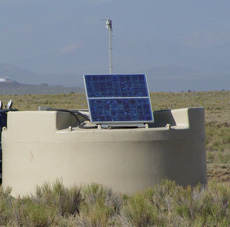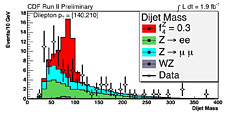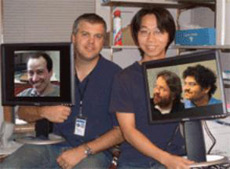|
Thursday, Aug. 21
THERE WILL BE NO PHYSICS AND DETECTOR SEMINAR THIS WEEK
2:30 p.m.
Theoretical Physics Seminar - Curia II
Speaker: S. Gopalakrishna, Brookhaven National Laboratory
Title: Heavy Electroweak Gauge Bosons at the LHC
3:30 p.m.
DIRECTOR'S COFFEE BREAK - 2nd Flr X-Over
THERE WILL BE NO ACCELERATOR PHYSICS AND TECHNOLOGY SEMINAR TODAY
Friday, Aug. 22
3:30 p.m.
DIRECTOR'S COFFEE BREAK - 2nd Flr X-Over
4:00 p.m.
Joint Experimental-Theoretical Physics Seminar - 1 West
Speakers: A. Vicini, University of Milano
Title: Drell-Yan Processes at Hadron Colliders
Click here for NALCAL,
a weekly calendar with links to additional information. |
|
Thursday, Aug. 21
- Minnesota wild rice w/chicken
- Tuna melt on nine grain
- *Italian meatloaf
- Chicken casserole
- *Vegetarian salad wrap
- Assorted slice pizza
- Mandarin chicken
*Smart Cuisine - Heart Healthy Choice
Wilson Hall Cafe menu |
|
Thursday, Aug. 21
Dinner
- Fresh tomato, mozzarella cheese with a basil dressing
- Grilled lamb chops
- Mushroom risotto
- Lemon sorbet with summer fruits
Wednesday, Aug. 27
Lunch
- Salad nicoise with fresh grilled tuna
- Lemon cake with blueberry coulis
Chez Leon menu
Call x4598 to make your reservation. |
|
|
Cosmic ray study reaps energy, economic benefits

Two solar panels and a battery pack power each of the Pierre Auger Observatory collaboration's 1,600 detectors.
U.S. Secretary of Energy Samuel Bodman last month set as key goals for his department using energy efficiently, researching alternative energies and bolstering foreign economies.
The Pierre Auger Observatory collaboration does all three, and that’s not even its main mission.
The collaboration studies the highest-energy cosmic rays, which strike the earth at a rate of one per square kilometer every century. That requires a lot of detectors with cheap power sources spread across a large area. Brazilian industry and a Spanish university tap into those research tools to improve consumer products.
“When we do science we use the best technology available. We use it as a tool to get our work done and the technology generally doesn’t do exactly what we want so we improve it. And that tends to benefit society,” said project manager Paul Mantsch.
As common with many high-energy physics ventures the tools needed for basic research discovery find new uses in industry or save time and money in product research and development.
Auger built detectors in ranching country in Argentina. Rather than pay to have power lines installed over 1,200 square miles, collaborators outfitted 1,600 detectors with two solar panels and a storage battery pack. This environmentally-friendly power system has created a giant quality assurance test for a Brazilian company supplying the batteries with the intent of expanding their use in Brazilian industry. Spain is benefitting by studying the data on the solar panels for use in its solar panel production.
“We didn’t use solar power to save the planet, it was the only way we could do the research,” said Peter Mazur, a physicist who works with tank, detector and solar power operations.
Likewise, the only way to expand the research to Pierre Auger North Observatory in Colorado is to create a more insulated detector tank.
Brazilian heat traditionally rots large amounts of silo-stored food. But by utilizing the new insulation process worked out with Mazur and Brazilian industry to create tanks for the future Auger experiment, Brazil is building cheaper, more efficient silos, Mazur said.
-- Tona Kunz
|
Chris Smith named director of Cerro Tololo Inter-American Observatory
From National Optical Astronomy Observatory News, Aug. 20, 2008
Dr. R. Chris Smith has been selected as the next director of Cerro Tololo Inter-American Observatory (CTIO). Smith will succeed Dr. Alistair Walker in November. Walker will return to the scientific staff of CTIO after five years as director.
Based in La Serena, Chile, CTIO is part of the National Optical Astronomy Observatory (NOAO), the US national observatory for nighttime optical/infrared astronomy funded by the National Science Foundation. On Cerro Tololo, CTIO operates the Blanco 4-meter telescope and a suite of one meter-class telescopes for a university consortium called SMARTS (as well as several tenant facilities). On nearby Cerro Pachón, CTIO operates the SOAR 4.1-meter telescope (on behalf of an international partnership) and supports U.S. participation in the international Gemini South 8-meter telescope.
"Chris has years of experience working for CTIO, he has led a major southern-sky survey of the Magellanic Clouds, and he recently headed the NOAO-wide Data Products Program during a period of extensive developments in virtual observatories," said NOAO Director David Silva. "I am confident he will excel in this new role as an observatory director.
Read more
|
Ace quantum mechanics-the reality TV way!
From Wired Magazine, Aug. 18, 2008
With CERN's Large Hadron Collider finally coming online, watercoolers around the world will soon be abuzz with talk of Higgs bosons, gluons, and other mind-blowing subatomic thingies. How to keep track of all that quantum fluff? It's easier than you think. Fans of shows like Survivor, American Idol, Top Chef, or America's Next Top Model already have the tools they need to wrap their heads around the fundamental bits in our universe. Turns out, if you understand reality TV, you can understand reality.
Gluons are the Donald Trumps, Tyra Bankses, and Mark Burnetts of the subatomic world. Just as these executive producers (often doubling as onscreen overlords) dictate the rules and force contestants into tightly knit alliances for survival, gluons wield what's called the strong nuclear force, impelling quarks to clump together into the neutrons and protons of an atom's nucleus.
Read more
|
|
|
Testing the Standard Model from A to ZZ

A comparison of the mass of the two-jet system between data, background and one possible anomalous coupling value (in red).
One of the fundamental goals of the Tevatron is to probe the boundaries of the Standard Model of particle physics by looking for signatures that the model does not predict. Of particular interest is the ZZ channel, which is a possible indicator of the existence of high-mass particles. CDF has now completed an analysis of ZZ Anomalous Triple Gauge Couplings, setting limits on the production of two Z bosons in violation of the Standard Model.
The CDF Anomalous Coupling result used 1.9 inverse femtobarns of data to search for the non-Standard Model production of two Zs. The data was searched in the dilepton-dijet channel where one Z decays to electrons or muons and the other Z decays into quarks, which appear inside the detector as a shower of particles referred to as a “jet.” The mass of the two jets was used to fit the data, comparing expected shapes from a Z against a background shape from Quantum Chromodymanics. The data was found to be consistent with the Standard Model, which allowed researchers to set very tight limits on possible Standard Model violations.
The results of this analysis provide the world's best limits on ZZ anomalous couplings, as well as direct limits on high-mass particles decaying to two Z bosons. Although no new physics was discovered, the limits represent stringent checks for the possible manifestation of new physics, as well as providing a foothold in a region at the edge of the Standard Model.
Learn more

Elliot Lipeles, University of Pennsylvania (in computer screen)
Mark Neubauer, University of Illinois, Urbana-Champaign (sitting)
Shih-Chieh Hsu, Lawrence Berkeley National Laboratory (standing)
Frank Wuerthwein, University of California, San Diego (computer screen, left side)
Rami Vanguri, University of California, San Diego (computer screen, right side).
Matthew Norman, University of California, San Diego (not pictured)
|
|
Have a safe day!
GSA triathlon Aug. 30
Fermilab's Graduate Student Association will host its annual triathlon on Saturday, Aug. 30, beginning at 7:30 a.m. The event will begin with an 800m swim in the Fermilab pool, continue with a 20km bike ride and finish with a 5km run. All events will occur on Fermilab property. Access more information on the event Web page. To sign up, e-mail the GSA Officers.
The University of Chicago Tuition Remission Program deadline today
The deadline to apply for the tuition remission program at The University of Chicago for the fall 2008 quarter is today. For more information and enrollment forms, contact Nicole Gee at x3697 or visit the Web site.
International Folk Dancing Thursday
International Folk Dancing will meet in Ramsey Auditorium on Thursday, Aug. 21. Dancing begins at 7:30 p.m. with teaching and children's dances earlier in the evening and request dancing later on. For more information, call (630) 584-0825 or (630) 840-8194 or e-mail folkdance@fnal.gov.
Altera's Quartus II Software Design classes
The Office for Professional and Organization Development will offer classes in Altera's Quartus II Software Design Series.
Altera's Quartus II Software Design Series: Timing Analysis - Sept. 16. Learn more and enroll.
Altera's Quartus II Software Design Series: Optimization - Sept. 17. Learn more and enroll.
The enrollment deadline for both classes is Aug. 29.
Blood Drive Aug. 26, 27
Fermilab's next blood drive will take place from 8 a.m. - 2 p.m. on Aug. 26 and 27. Heartland Blood Centers will take donations in the Wilson Hall ground floor NE Training Room. To ensure enough BBQ sets and aprons are aviailable for all who donate, appointments are encouraged, although walk-ins are welcome. Schedule appointments online or call Diana at x3771 or Margie at x5680.
Megafloods lecture Sept. 12
Megafloods are the largest known freshwater floods with flows comparable in scale to ocean currents. They are capable of inducing global changes in climate. Fermilab Lecture Series will present a lecture on these floods by Dr. Victor Baker from the University of Arizona on Friday, Sept. 12, at 8 p.m. Tickets are $5. More information.
Additional Activities
|
|